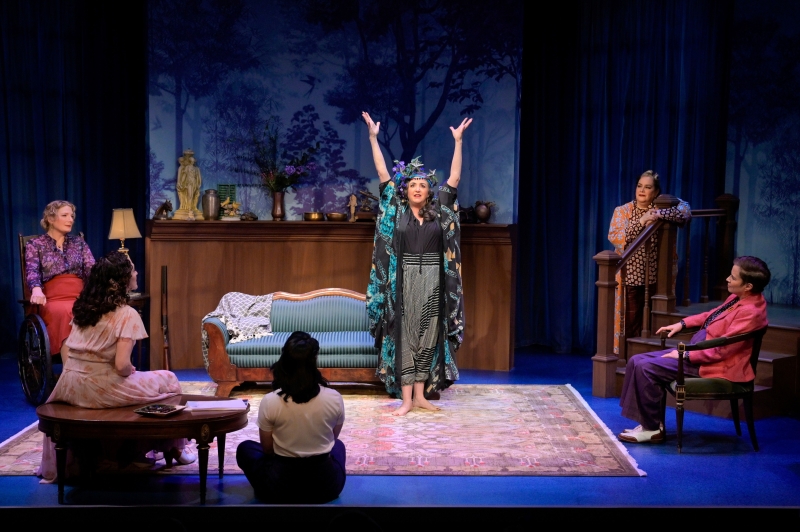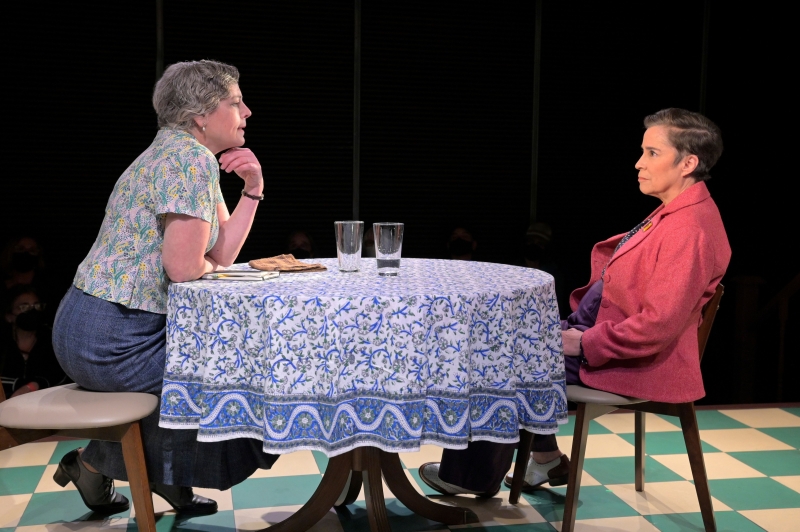Review: FEFU AND HER FRIENDS at A.C.T. Delivers a Uniquely Compelling Theatrical Experience
The funny and moving production of the seminal feminist play runs live at the Strand Theater through May 1st

(L-R): Lisa Anne Porter (Julia), Sarita Ocón (Christina), Jennifer Ikeda (Cindy), Cindy Goldfield (Emma),
a??a??a??Catherine Castellanos (Fefu) & Marga Gomez (Cecilia) in Fefu and Her Friends at A.C.T.
Among theater nerds, María Irene Fornés' groundbreaking 1977 Fefu and Her Friends is something of a holy grail - everyone seems to revere it, but so few have actually seen it. So, first off, kudos to A.C.T. for bringing us a bracing production of this seminal play. Given its vaunted if elusive reputation, I'll admit I went in with more than a little trepidation that I would find the whole affair impenetrable or, even worse, merely edifying, some dry exercise in academic writing. Well, I am pleased to report that I was seriously mistaken. News flash - Fefu and Her Friends is surprisingly fun and funny and often quite moving.
Much of the play's reputation comes from its unorthodox structure - sandwiched between its long opening and closing scenes are four short scenes performed simultaneously in different spaces throughout the building. The audience is split into four groups who move around the building to watch those scenes in different orders. While this might sound confusing or overly fussy in description, in practice it is not. What in 1977 may have been pretty revolutionary is now closer to common practice with the advent of shows like Sleep No More and Taylor Mac's A 24-decade History of Popular Music. The perambulatory nature of Fefu reconnects us with the childlike wonder of first experiencing the magic of live theater. We all feel like kids again, going on a treasure hunt or exploring a haunted house.
The other thing that makes this play's reputation is Fornés' writing style, which is grounded in realism, but occasionally includes poetry and other flights of fancy. This is also what makes the work so hard to describe. On the surface, the situation couldn't be simpler: one by one a group of women circa 1935 gather in the well-appointed living room of Fefu's country house to rehearse their presentation for a charity event. If it weren't for the title character's decidedly unorthodox nature, this could be the setup for a droll drawing room comedy, an Agatha Christie murder mystery or a rehash of Clare Boothe Luce's The Women. Well, to some degree, Fefu and Her Friends is all those things - and more.

Fornés is a master at creating epigrammatic lines that work on multiple levels. For instance, when an exasperated Fefu grumbles that people just don't understand the importance of plumbing, the line gets a laugh at the vacuity of her statement. And then as it rattles around in your brain for a second, you think, "Huh - was she referring to hardware or body parts?" My guess is that Fornés means you to hear it both ways, as her characters have a tendency to blithely muse on the status of women in the world. Fornés combines a frivolous surface with deadly serious undercurrents, resulting in a light comedy anchored by wry observations on the plight of the human condition and unsettling questions around matters of mortality. The quotidian coexists with the existential in a way that makes it easy to understand why so many contemporary playwrights cite Fornés as a major influence on their work. You could read almost any section of this play and think, "Aha, so that's where Tony Kushner got the audacity to write Perestroika!"
As is the case with that particular Kushner work, I'm not 100% convinced that the whole thing adds up to a coherent play, but it sure is a lot of fun to go on the journey. And for that we have to thank Pam MacKinnon's crisp and cogent production. Her extensive experience directing the work of Edward Albee (whose style seems to be a sort of precursor to Fefu) stands her in good stead. Most importantly, she has gotten all of her actors on the same page, as they all ground even their more outrageous lines in recognizable human feeling. When Fefu opens the play with "My husband married me to have a constant reminder of how loathsome women are," she lets the line speak for itself, devoid of irony or camp. That simple, matter-of-fact approach makes you actually sit up and listen to the words, even as you are appalled by them.

There is some terrific design work going on here, particularly in Tanya Orellana's period-perfect sets and Russell H. Champa's moody lighting. The disparate settings, aside from a decidedly deconstructed garden, are all of a piece and speak of comfortable wealth in a way that is both nostalgic and a little mustily creepy. The spaces are decked out with all manner of Art Deco and Art Nouveau knickknacks and tchotchkes that set the play firmly in time, and the kitchen is a specific color of green that feels permanently etched in 1935.
This level of detail is also helpful as it gives us something to focus on while waiting a few minutes for each of the four shorter scenes to commence. I do wish that the transitions between the four shorter scenes could have been accomplished more swiftly, as the energy of the play dissipates somewhat as we wait for the next scene to begin. But I also understand that the cast and backstage crew are performing some very tricky maneuvers here. Each scene must begin at exactly the same time, as at least one character will make an entrance mid-scene, having come from a different scene elsewhere in the building. Stage Manager Elisa Guthertz certainly has her work cut out for her in directing all that traffic!

and Sarita Ocón in Fefu and Her Friends
Of course, the play wouldn't work at all without a top-notch cast, which it mainly gets here. While a few of the actors felt like they hadn't yet fully discovered how their characters fit within the multi-layered style of the play, there are several standout performances. First off, if you don't have a kickass Fefu, then you don't have a play, and Catherine Castellanos is most definitely a kickass Fefu. With her sometimes abhorrent pronouncements, it's a very tricky role requiring an actor of immense charm to not completely alienate the audience, and Castellanos has charm in spades. She is absolutely delicious in the role, making a captivating hostess for the proceedings, whether she's entertaining her guests, aiming a gun at her husband in the back garden or fixing the faulty plumbing. Castellanos also has the superb actor's knack for spouting the most surreal or poetic language and making it sound like natural speech, as though she is expressing ideas that have just sprung to mind. As the play goes off in different directions, Castellanos provides the centrifugal force that holds the whole thing together. I know it's only early April, but I doubt there will be a better performance on a Bay Area stage this year.
I also very much enjoyed Lisa Anne Porter's mix of strength and vulnerability as wheelchair-bound Julia, whose sort of fever dream sets the denouement in motion. Stacy Ross gives a beautifully understated and layered performance as struggling-to-find-her place Paula, simultaneously funny and sad. Cindy Goldfield livens the piece as the most theatrically inclined of the women. And it is a kick to see the celebrated solo performer Marga Gomez working as part of an ensemble for a change. She proves her stage chops in a gorgeously low-key, complex and heartbreaking kitchen scene with Ross.
(all photos by Kevin Berne)
Live performances of Fefu and Her Friends continue through May 1st at A.C.T.'s Strand Theater, 1127 Market Street, San Francisco, CA. Running time is approximately 2:30, including one intermission. For tickets and additional information, visit act-sf.org/fefu.
Reader Reviews
Videos

